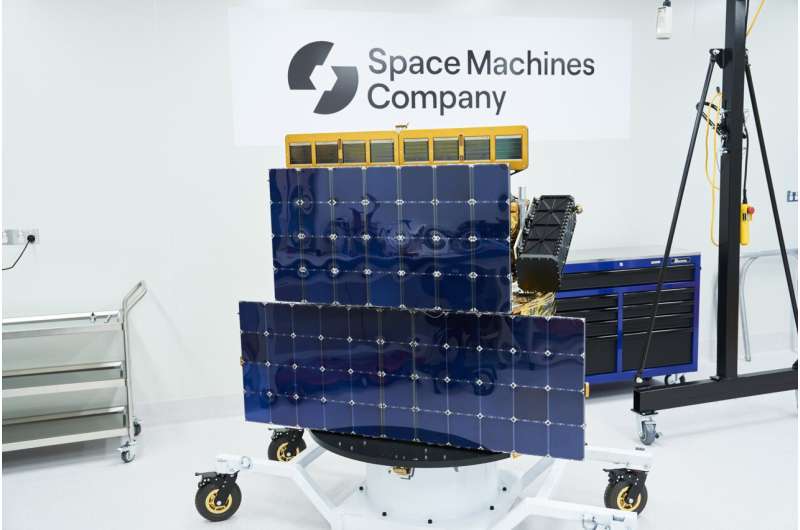This article has been reviewed according to Science X's editorial process and policies. Editors have highlighted the following attributes while ensuring the content's credibility:
fact-checked
trusted source
proofread
Next-gen printed flexible solar cells launched into space

State-of-the-art printed flexible solar cell technology developed by Australia's national science agency, CSIRO, was successfully launched into space today (March 5) aboard Australia's largest private satellite, Optimus-1, on Space X's Transporter-10 mission.
CSIRO is exploring the potential of printed flexible solar cells as a reliable energy source for future space endeavors, in collaboration with Australian space transportation provider, Space Machines Company.
CSIRO Space Program Director Dr. Kimberley Clayfield said a major challenge in the development of spacecraft is low-mass, high-efficiency power systems.
"CSIRO's printed flexible solar cells could provide a reliable, lightweight energy solution for future space operations and exploration," Dr. Clayfield said.
"If the space flight test reveals similar performance as we've shown in the lab, this technology offers significant advantages over traditional silicon-based solar.
"Yet another example of CSIRO's terrestrial expertise being applied to solve challenges in the space domain."
CSIRO Renewable Energy Systems Group Leader Dr. Anthony Chesman said eight mini-modules of CSIROs Australian-made printed flexible solar cells were attached to the surface of Space Machine Company's Optimus-1 satellite.
"CSIRO researchers have been working for many years to improve our solar cell performance using perovskite—an advanced material that is highly efficient in converting sunlight into energy," Dr. Chesman said.
"Our perovskite cells have been achieving incredible outcomes on Earth and we're excited that they'll soon be showcasing their potential in space."
Rajat Kulshrestha, Space Machines Company CEO, said the completion of Optimus marks a major milestone for Space Machines Company.
"Through perseverance and teamwork, our engineers and scientists, alongside partners like CSIRO, have created something truly ground-breaking," Kulshrestha said.
"CSIRO's innovative flexible solar cells will transform spacecraft power systems and enable new possibilities for future space missions.
"We're thrilled to integrate this ground-breaking technology into Optimus. This is just the beginning, and I'm excited to see what the future holds as we continue to innovate."
Dr. Chesman said in situ testing would secure information on the performance of the perovskite cells as they orbit the planet.
"We will get information on how the panels are holding up under the extreme conditions in space and data on the efficiency they achieve," Chesman said.
Chesman said the team had already undertaken pioneering research on the likely performance of the cells in a space environment.
"Based on our research we expect our printed flexible solar cells will stand up to the effects of cosmic electron and gamma radiation which can compromise the performance and integrity of traditional solar cells," Chesman said.
"We are also confident these cells will outperform traditional cells in cases where sunlight hits them at non-optimal angles.
"The feedback we receive from the satellite will provide valuable insights into the practical application of our technology and inform future technology development."
Chesman highlighted the unique opportunity the solar technology could present for Australian manufacturing.
"This is a great opportunity for Australian technology to contribute to global space exploration. We are eager to collaborate with potential partners to explore this further," he said.
CSIRO research exploring the potential of printed flexible solar cells in space is available in a recent paper published in ACS Applied Energy Materials.
More information: Dechan Angmo et al, Toward Rollable Printed Perovskite Solar Cells for Deployment in Low-Earth Orbit Space Applications, ACS Applied Energy Materials (2024). DOI: 10.1021/acsaem.3c02761


















